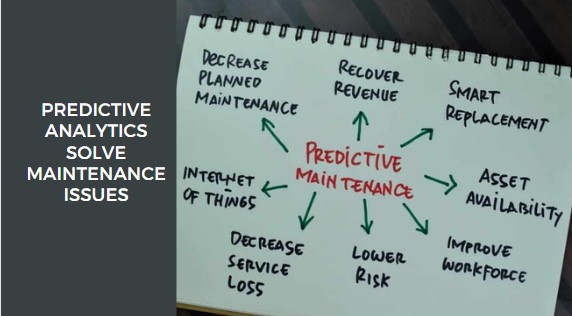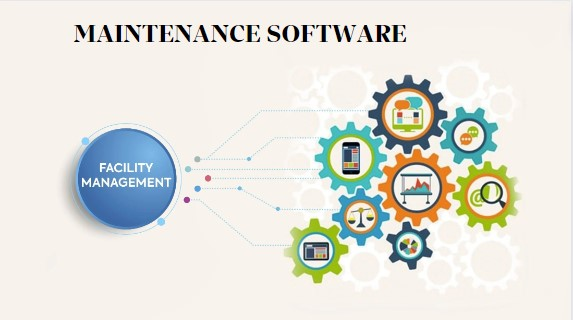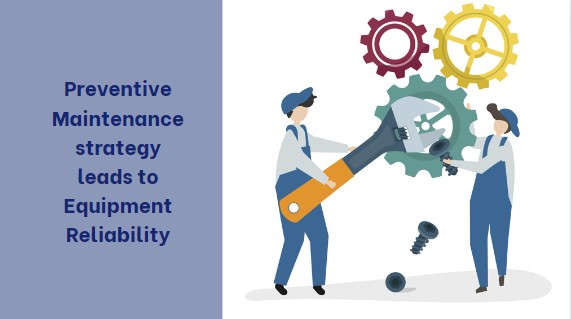
How Predictive Analytics Solve Maintenance Issues
Madhurima Sanyal |
16 Apr 2024 |
12:53 PM
- Understanding Predictive Analytics in Maintenance
- Predictive Maintenance Overview
- How Does Predictive Maintenance Work?
- Who Uses Predictive Maintenance?
- Advantages and Disadvantages of Predictive Maintenance
- The Impact of Predictive Maintenance
- Benefits of Predictive Analytics
- Building a Data-Powered Predictive Maintenance Program: A Step-by-Step Guide
- Implementing Predictive Analytics in Maintenance
- How is Predictive Maintenance Related to Predictive Analytics?
- Industry Applications and Future Trends
- Future of Predictive Maintenance
- Predictive Maintenance Challenges
- Conclusion

Predictive maintenance is the future of Facility Management
Viki Dongare 27 Mar 2024 | 14:59 PMUnlock efficiency and reliability with predictive maintenance in facility management. Embrace advanced technologies for proactive solutions and optimized operations....
In today’s fast-paced industrial landscape, the maintenance of critical assets is paramount for ensuring uninterrupted operations and minimizing downtime. This is where predictive analytics emerges as a game-changer. Predictive analytics in maintenance involves harnessing the power of data to forecast equipment failures before they occur, allowing for proactive intervention.
By contrast, reactive maintenance, which addresses issues only after they arise, often leads to costly downtime and unexpected failures. Predictive maintenance, fueled by machine learning algorithms and advanced predictive maintenance tools, revolutionizes this approach by analyzing historical data and real-time sensor data to predict equipment failure with remarkable accuracy.
Understanding Predictive Analytics in Maintenance
Through predictive maintenance solutions, organizations can transition from a reactive to a preventive maintenance strategy, thereby optimizing asset performance and reducing unplanned downtime. In this article, we delve into the intricacies of predictive analytics, exploring its benefits, challenges, and practical applications in modern maintenance management. Let’s embark on a journey to unravel the transformative potential of predictive maintenance.
Predictive Maintenance Overview
What is Predictive Maintenance (PdM)?

Predictive maintenance (PdM) is a proactive maintenance strategy that leverages advanced data analytics techniques to predict when equipment failures are likely to occur. Unlike reactive maintenance, which addresses issues only after they happen, predictive maintenance relies on historical data, real-time sensor data, and machine learning algorithms to forecast potential failures before they disrupt operations.
How Does Predictive Maintenance Work?
Predictive maintenance works by collecting and analyzing data from various sources, such as sensors embedded in equipment, historical maintenance records, and operational data. Machine learning algorithms are then applied to this data to identify patterns and anomalies indicative of impending failures. By continuously monitoring equipment health and performance metrics, predictive maintenance algorithms can provide early warnings of potential issues, enabling maintenance teams to intervene proactively.
Who Uses Predictive Maintenance?
Predictive maintenance is utilized across a wide range of industries, including manufacturing, energy, transportation, and healthcare. Maintenance teams and facility managers are the primary users of predictive maintenance solutions, as they are responsible for ensuring the reliability and availability of critical assets. By adopting predictive maintenance practices, organizations can optimize maintenance schedules, reduce downtime, and extend the lifespan of their equipment.
Advantages and Disadvantages of Predictive Maintenance
One of the key advantages of predictive maintenance is its ability to prevent unexpected equipment failures, thereby minimizing downtime and reducing maintenance costs. By addressing issues before they escalate, organizations can improve asset performance and operational efficiency. Additionally, predictive maintenance enables maintenance teams to prioritize maintenance tasks based on the severity of potential failures, optimizing resource allocation.

However, predictive maintenance also has its limitations. Implementing predictive maintenance solutions requires significant investment in data collection infrastructure, analytics tools, and training for maintenance personnel. Moreover, predictive maintenance algorithms may not always accurately predict failures, leading to false alarms or missed opportunities for intervention. Despite these challenges, the benefits of predictive maintenance far outweigh the drawbacks for many organizations.
The Impact of Predictive Maintenance
The impact of predictive maintenance extends beyond just cost savings and operational efficiency. By proactively addressing equipment issues, organizations can enhance safety, minimize environmental impact, and improve overall asset reliability. Predictive maintenance also enables organizations to transition from reactive to preventive maintenance strategies, reducing the need for costly emergency repairs and extending the lifespan of critical assets.

In summary, predictive maintenance is a powerful tool for optimizing maintenance operations and maximizing asset performance. By harnessing the capabilities of data analytics and machine learning, organizations can unlock new insights into their equipment health and make informed decisions that drive business success. As the digitalization of maintenance continues to evolve, predictive maintenance will play an increasingly critical role in shaping the future of asset management.
Benefits of Predictive Analytics
Empowering Your Maintenance Team
Predictive analytics empowers maintenance teams by providing them with valuable insights into equipment health and performance. By leveraging predictive models and real-time data analytics, maintenance teams can anticipate potential failures and plan preventive maintenance activities accordingly. This proactive approach enables maintenance personnel to stay ahead of issues, reducing the likelihood of unexpected downtime and costly repairs. Additionally, predictive analytics allows maintenance teams to optimize their workflow by prioritizing tasks based on the criticality of equipment and the severity of potential failures. This not only improves operational efficiency but also enhances overall asset reliability.
Leveraging Data Analytics for Optimization
Data analytics plays a crucial role in optimizing maintenance operations. By analyzing historical maintenance data and real-time sensor data, organizations can identify patterns and trends that provide valuable insights into equipment performance and failure modes. Predictive models developed through data analytics enable organizations to forecast equipment failures with greater accuracy, allowing for proactive intervention. Furthermore, data analytics can be used to optimize maintenance schedules, ensuring that maintenance activities are performed at the most opportune times to minimize disruption to operations. Overall, leveraging data analytics for optimization enables organizations to reduce downtime, improve asset reliability, and achieve significant cost savings.
Incorporating predictive analytics into maintenance practices not only empowers maintenance teams but also drives operational excellence and business success. By harnessing the power of data analytics and predictive models, organizations can transform their maintenance operations from reactive to proactive, leading to improved equipment reliability, reduced downtime, and enhanced cost savings. As the field of predictive analytics continues to evolve, organizations that embrace these technologies will gain a competitive advantage in today's dynamic business environment.
Building a Data-Powered Predictive Maintenance Program: A Step-by-Step Guide
Predictive maintenance has emerged as a key strategy for optimizing maintenance operations and maximizing asset performance. Building a data-powered predictive maintenance program requires careful planning and execution. In this step-by-step guide, we outline the key components of establishing a successful predictive maintenance program.
Data Collection and Integration - The first step in building a data-powered predictive maintenance program is to collect relevant data from various sources, including sensors, maintenance logs, and operational records. This data must be integrated into a centralized database to ensure accessibility and consistency. Utilizing computerized maintenance management systems (CMMS) facilitates data collection and streamlines the integration process.
Data Preprocessing and Cleaning - Once the data is collected, it must undergo preprocessing and cleaning to ensure its quality and reliability. This involves identifying and correcting errors, removing outliers, and standardizing data formats. Data preprocessing is essential for ensuring the accuracy and effectiveness of subsequent analysis and modeling efforts.

Data Analysis and Machine Learning - With clean and processed data in hand, the next step is to perform data analysis and apply machine learning algorithms to identify patterns and trends. Data analysis techniques such as descriptive analytics, diagnostic analytics, and predictive analytics are used to gain insights into equipment performance and failure modes. Machine learning algorithms, including regression analysis, decision trees, and neural networks, are then applied to develop predictive models.
Anomaly Detection - Anomaly detection is a critical component of predictive maintenance, as it enables early identification of abnormal behavior or potential equipment failures. By monitoring real-time data streams, anomalies can be detected and flagged for further investigation. Advanced anomaly detection techniques, such as statistical methods and machine learning algorithms, enhance the accuracy and efficiency of predictive maintenance programs.
Predictive Model Development - Anomaly detection is a critical component of predictive maintenance, as it enables early identification of abnormal behavior or potential equipment failures. By monitoring real-time data streams, anomalies can be detected and flagged for further investigation. Advanced anomaly detection techniques, such as statistical methods and machine learning algorithms, enhance the accuracy and efficiency of predictive maintenance programs.
Scheduling Optimization - Once predictive maintenance models are in place, maintenance schedules can be optimized to prioritize tasks based on the severity of potential failures and the availability of resources. By aligning maintenance activities with predicted maintenance needs, organizations can minimize downtime, reduce maintenance costs, and improve overall operational efficiency.

Continuous Improvement - Building a data-powered predictive maintenance program is an ongoing process that requires continuous monitoring, evaluation, and improvement. By collecting feedback from maintenance activities and analyzing performance metrics, organizations can identify areas for optimization and refinement. Continuous improvement ensures that predictive maintenance programs remain effective and adaptive to changing operational needs.
Building a data-powered predictive maintenance program requires careful planning, robust data management processes, and advanced analytics capabilities. By following this step-by-step guide, organizations can harness the power of data analytics and machine learning to optimize maintenance operations, reduce downtime, and achieve significant cost savings.
Implementing Predictive Analytics in Maintenance
Challenges in Implementing Predictive Analytics for Facility Maintenance

While predictive analytics holds great promise for revolutionizing maintenance practices, implementing it comes with its own set of challenges. One of the primary hurdles is the complexity of integrating predictive analysis into existing maintenance workflows and systems. Organizations often struggle with data silos, where relevant data is stored in disparate systems that are not easily accessible or compatible. Additionally, ensuring data quality and consistency is crucial for accurate predictive modeling. Cleaning and preprocessing data to remove noise and inconsistencies can be time-consuming and resource-intensive.
Another challenge is the shortage of skilled personnel with expertise in data analytics and machine learning. Data scientists, who are instrumental in developing and deploying predictive models, are in high demand but in short supply. Organizations may face difficulties in recruiting and retaining talent with the necessary skills to effectively implement predictive analytics in maintenance.
Furthermore, there may be resistance to change from maintenance teams accustomed to traditional maintenance practices. Convincing frontline maintenance workers to embrace predictive analytics and trust predictive models requires effective communication and training. Additionally, integrating predictive maintenance into existing maintenance scheduling and workflows can be disruptive and met with skepticism.
How is Predictive Maintenance Related to Predictive Analytics?
Predictive maintenance and predictive analytics are closely intertwined, with predictive analytics serving as the foundation for predictive maintenance strategies. Predictive analytics involves analyzing historical data, real-time sensor data, and other relevant sources to forecast future events or trends. In the context of maintenance, predictive analytics is used to develop predictive models that anticipate equipment failures and maintenance needs.
Predictive maintenance, on the other hand, is the application of predictive analytics to maintenance practices. It involves using predictive models to schedule maintenance activities based on predicted failure probabilities, rather than fixed time intervals or reactive responses to failures. By leveraging predictive analytics, organizations can transition from reactive or preventive maintenance approaches to predictive maintenance, thereby reducing downtime, optimizing maintenance schedules, and minimizing operational costs.

While implementing predictive analytics in maintenance presents its challenges, overcoming these obstacles can lead to significant improvements in maintenance effectiveness and efficiency. By addressing data integration issues, investing in talent development, and fostering a culture of innovation and collaboration, organizations can successfully harness the power of predictive analytics to drive proactive maintenance strategies and achieve operational excellence.
Industry Applications and Future Trends
Industries Benefiting from Predictive Maintenance
Predictive maintenance is revolutionizing maintenance practices across a wide range of industries, enhancing operational efficiency, and reducing downtime. Manufacturing industries, including automotive, aerospace, and electronics, are among the early adopters of predictive maintenance due to the criticality of equipment uptime and the potential for significant cost savings. By implementing predictive maintenance solutions, manufacturers can optimize production processes, minimize unplanned downtime, and extend the lifespan of equipment.
In the transportation sector, predictive maintenance is being used to monitor the health of aircraft engines, railway tracks, and vehicle fleets. By leveraging real-time sensor data and predictive models, transportation companies can identify potential issues before they escalate into costly failures, ensuring passenger safety and operational reliability.

The energy and utilities sector is also embracing predictive maintenance to improve the reliability and performance of infrastructure assets such as power plants, pipelines, and renewable energy installations. By proactively monitoring equipment health and predicting failures, energy companies can reduce maintenance costs, optimize energy production, and enhance grid resilience.
Healthcare facilities are leveraging predictive maintenance to ensure the reliability of medical equipment and minimize disruptions to patient care. By implementing predictive maintenance solutions for critical medical devices such as MRI machines and X-ray equipment, healthcare providers can improve patient outcomes and reduce the risk of equipment failures during medical procedures.
Future of Predictive Maintenance
The future of predictive maintenance is promising, with advancements in data analytics, machine learning, and sensor technology driving innovation in the field. Predictive maintenance solutions are becoming increasingly sophisticated, incorporating advanced analytics techniques such as deep learning and predictive modeling to improve accuracy and reliability.
Additionally, the rise of Internet of Things (IoT) technology is enabling the proliferation of connected sensors and devices, providing real-time insights into equipment health and performance. By harnessing IoT data streams, organizations can enhance predictive maintenance capabilities and unlock new opportunities for optimization and automation.
Predictive Maintenance Challenges
Despite its potential benefits, predictive maintenance faces several challenges, including data quality issues, integration complexities, and cultural barriers to adoption. Organizations must overcome these obstacles by investing in data management infrastructure, fostering collaboration between maintenance teams and data scientists, and promoting a culture of innovation and continuous improvement.
Predictive maintenance is poised to transform maintenance practices across various industries, driving operational excellence and cost savings. By leveraging predictive analytics and embracing technological advancements, organizations can stay ahead of the curve and unlock new opportunities for efficiency and growth.
Conclusion
The adoption of predictive maintenance marks a significant shift in maintenance strategies, offering organizations the opportunity to proactively manage their assets, minimize downtime, and optimize operational efficiency. Throughout this exploration of predictive analytics in maintenance, it has become evident that the benefits are substantial, ranging from cost savings to improved asset performance and reliability.
By leveraging predictive models and real-time data analytics, organizations can anticipate equipment failures before they occur, allowing for timely intervention and preventive measures. This proactive approach not only reduces maintenance costs associated with unplanned downtime and emergency repairs but also extends the lifespan of critical assets, ultimately enhancing return on investment.
Furthermore, predictive maintenance empowers maintenance teams by providing them with valuable insights into equipment health and performance. Armed with predictive analytics tools and solutions, maintenance personnel can prioritize tasks, optimize maintenance schedules, and allocate resources more effectively. This not only improves operational efficiency but also enhances overall asset reliability and performance.
The integration of predictive maintenance into existing maintenance workflows and systems may pose challenges, including data quality issues, talent shortages, and resistance to change. However, organizations that successfully overcome these obstacles stand to gain a competitive edge in today's fast-paced business environment.
Looking ahead, the future of predictive maintenance is promising, with advancements in data analytics, machine learning, and IoT technology driving innovation in the field. Effective predictive maintenance solutions will continue to evolve, becoming more sophisticated and reliable, enabling organizations to unlock new opportunities for optimization and automation.
In order to fully realize the benefits of predictive maintenance, organizations must embrace a culture of innovation and continuous improvement. This involves investing in data management infrastructure, fostering collaboration between maintenance teams and data scientists, and promoting a proactive approach to asset management.
In conclusion, predictive maintenance is not just a buzzword or a passing trend; it is a strategic imperative for organizations seeking to stay ahead in today's competitive landscape. By harnessing the power of predictive analytics, organizations can transform their maintenance practices, drive operational excellence, and achieve sustainable growth in the long term. The journey towards predictive maintenance may be challenging, but the rewards are undoubtedly worth the investment.